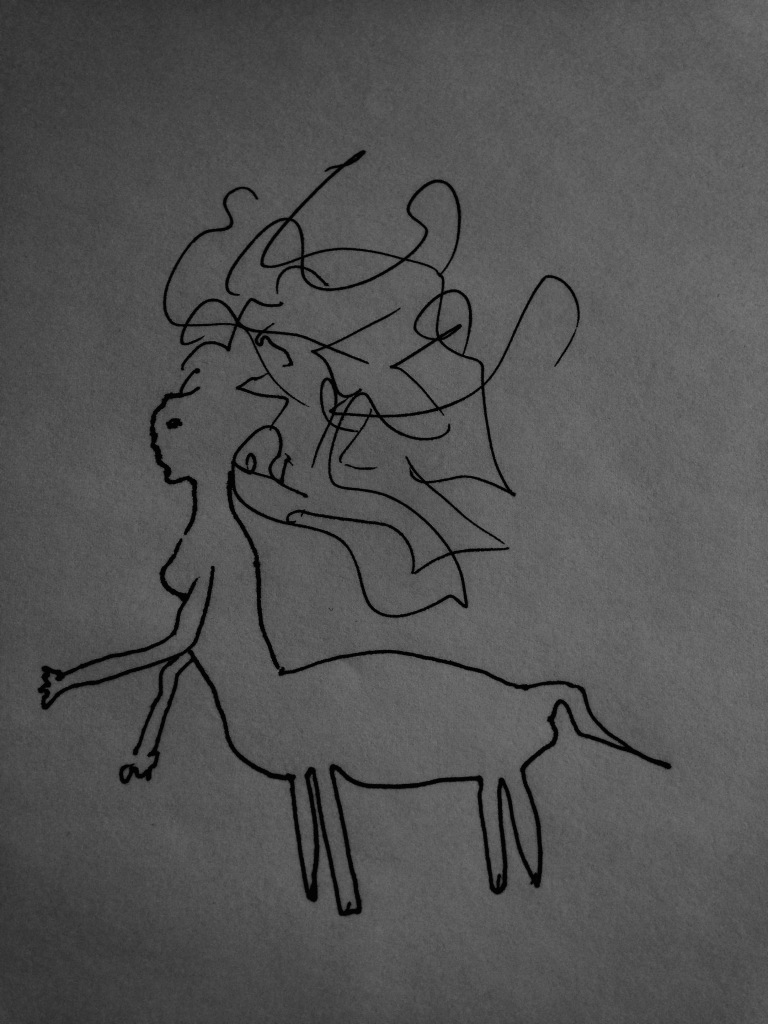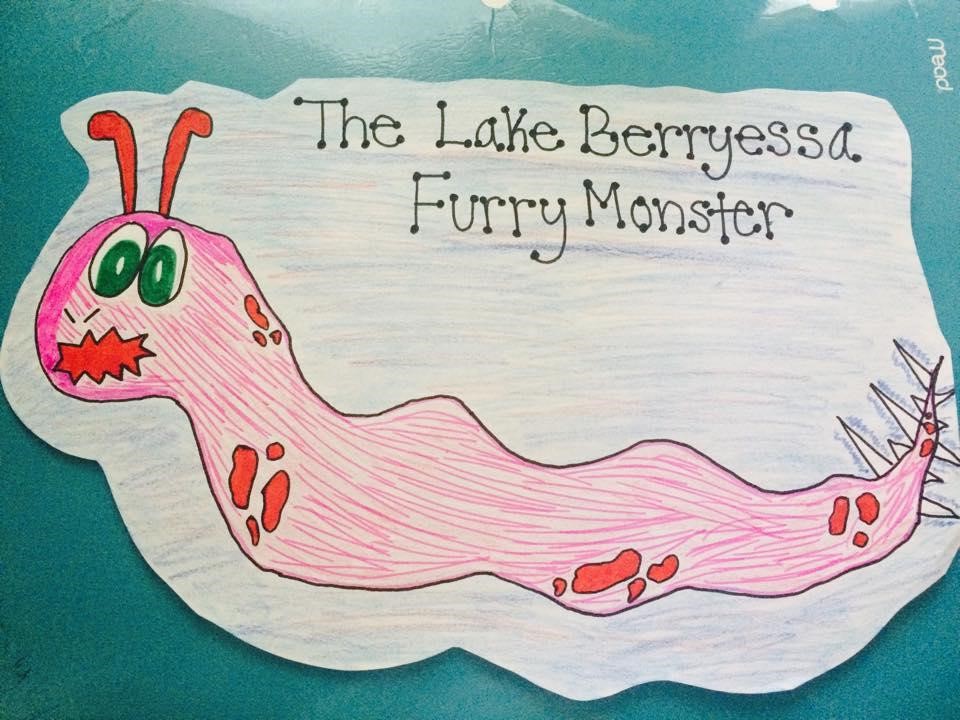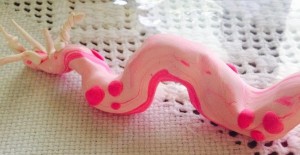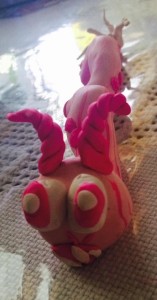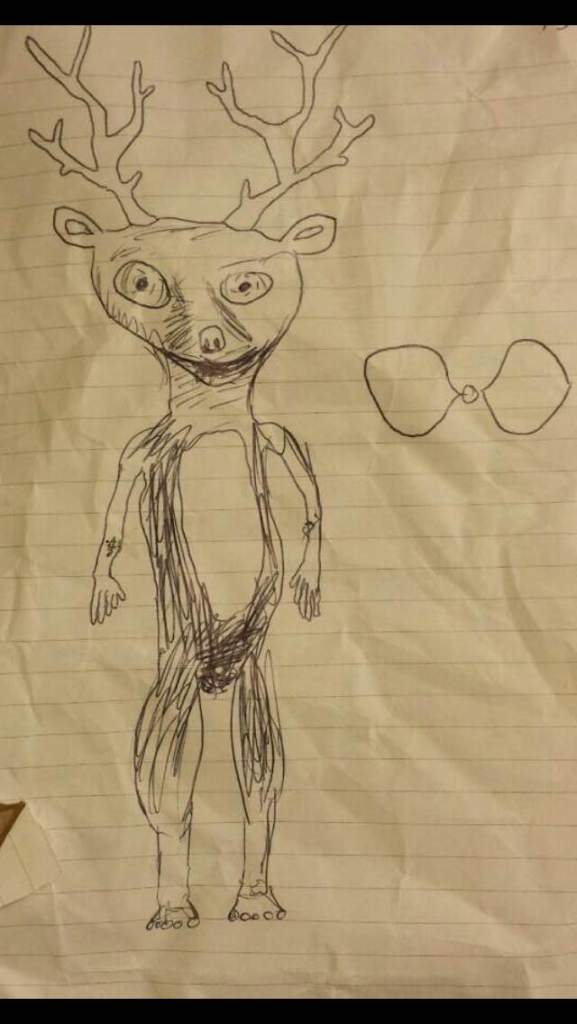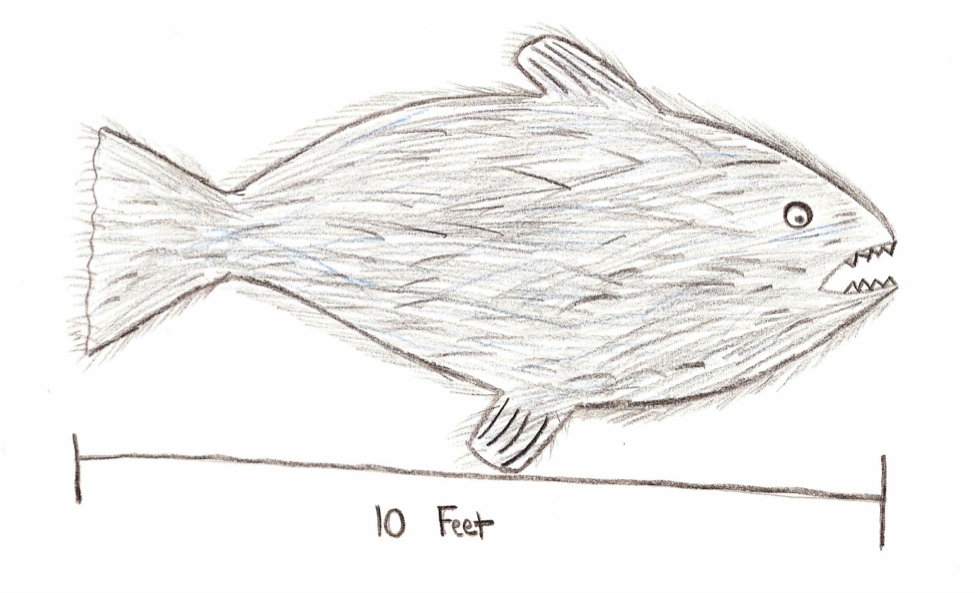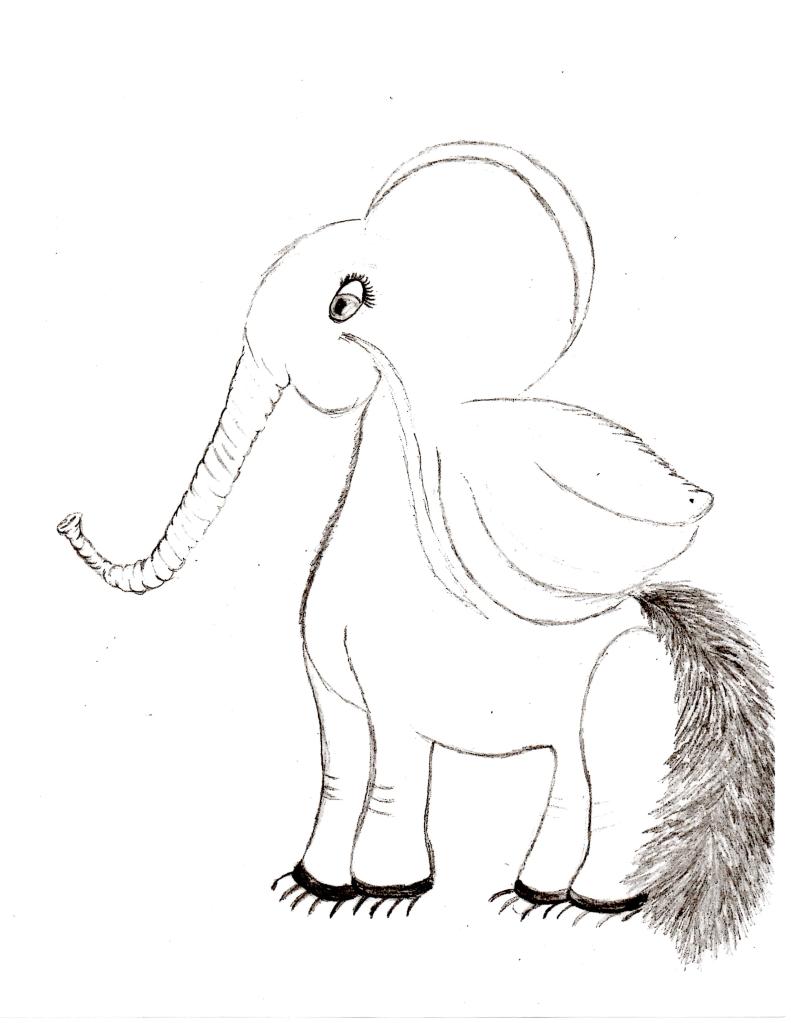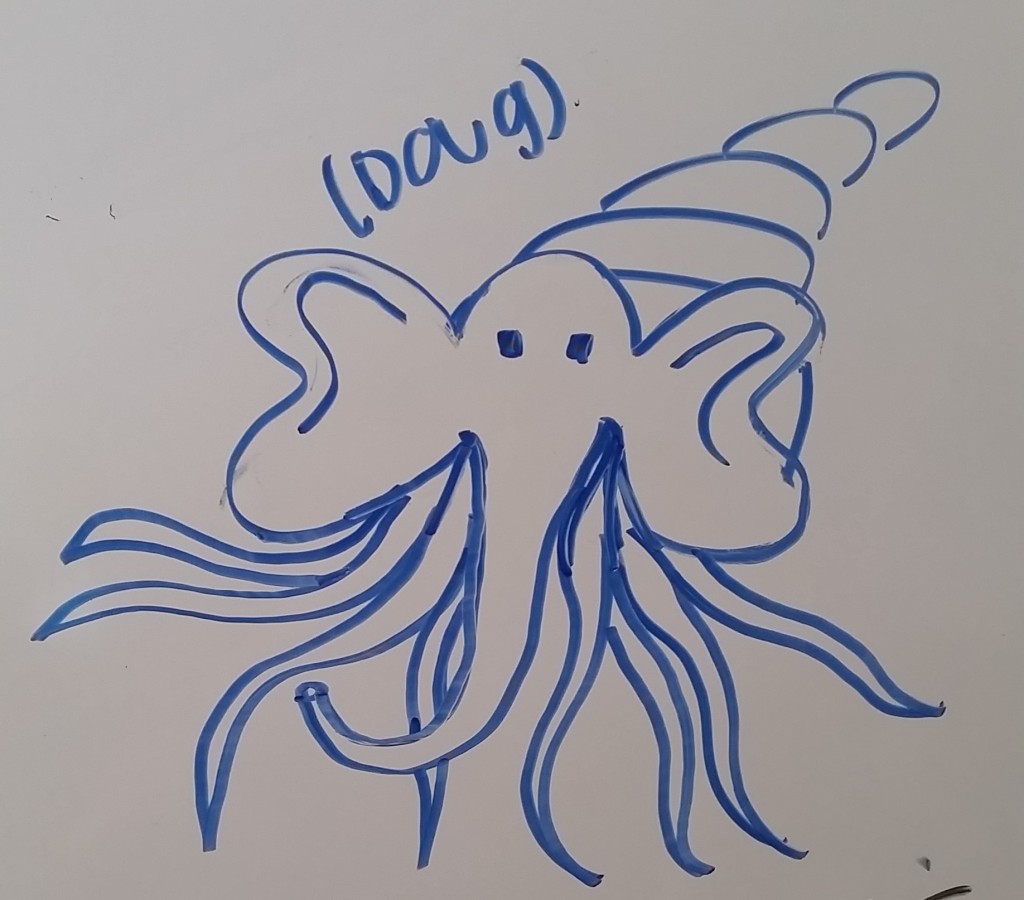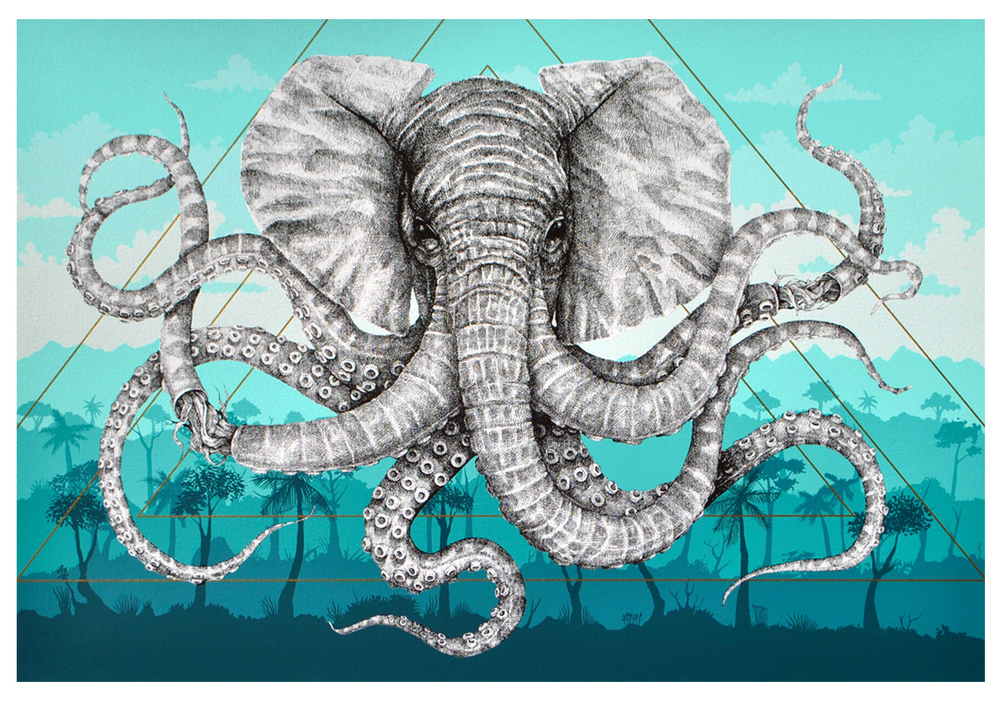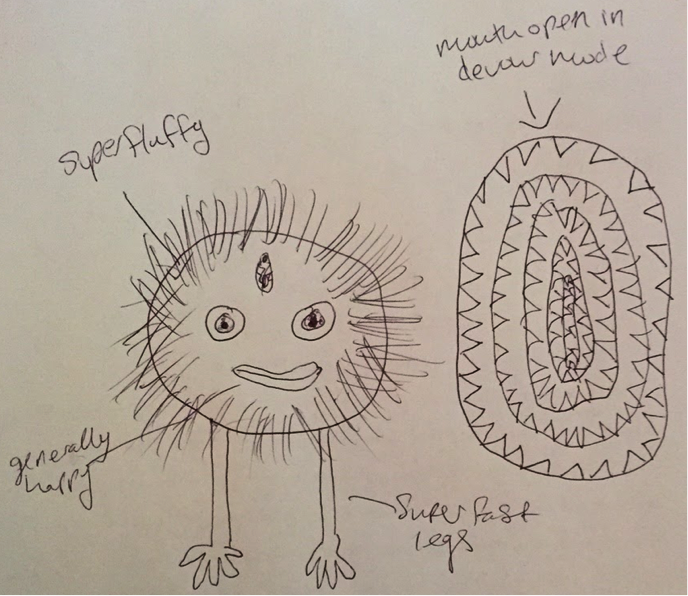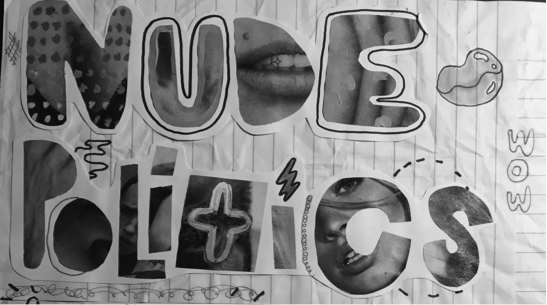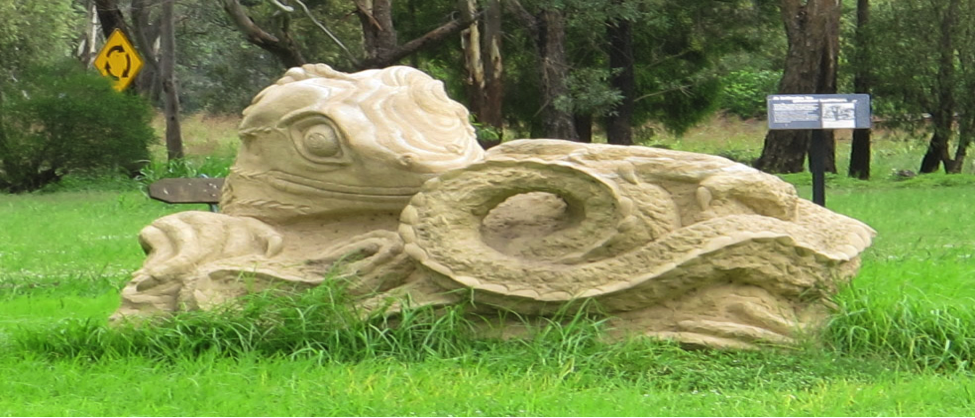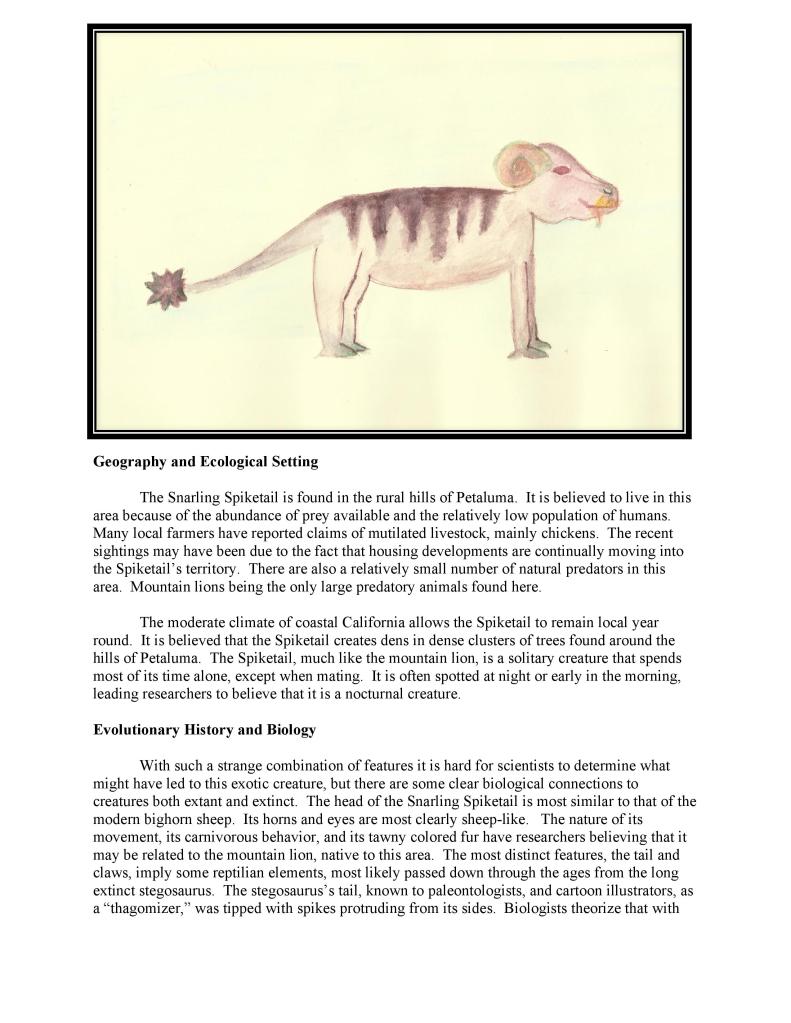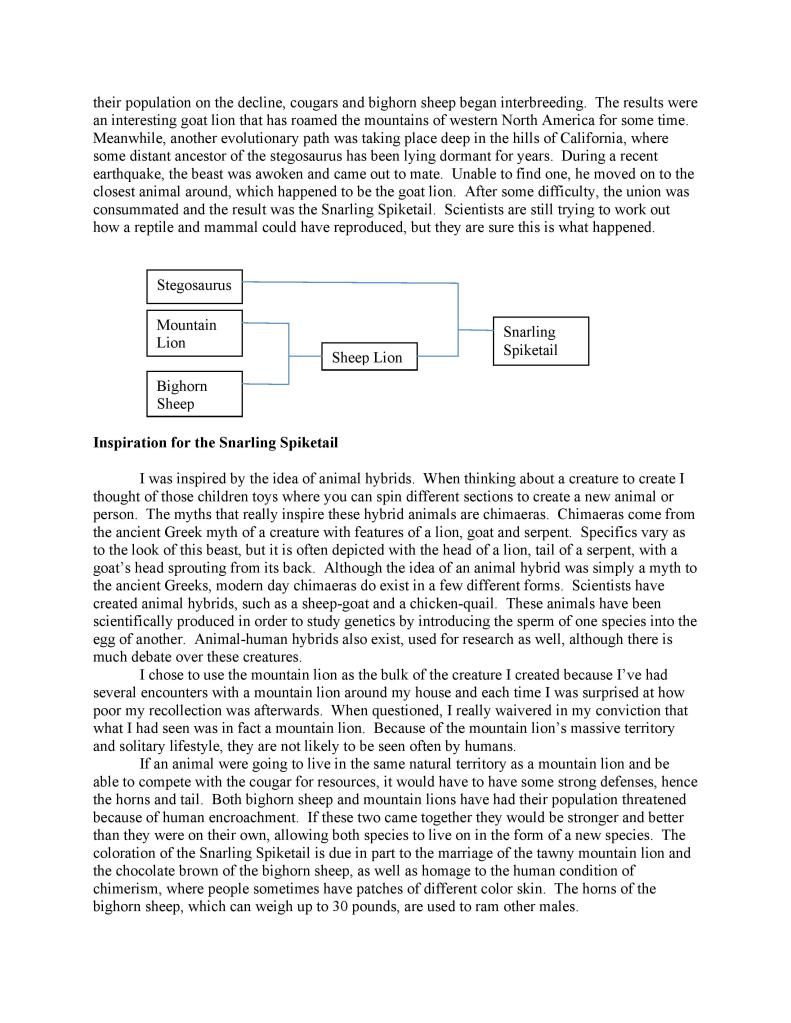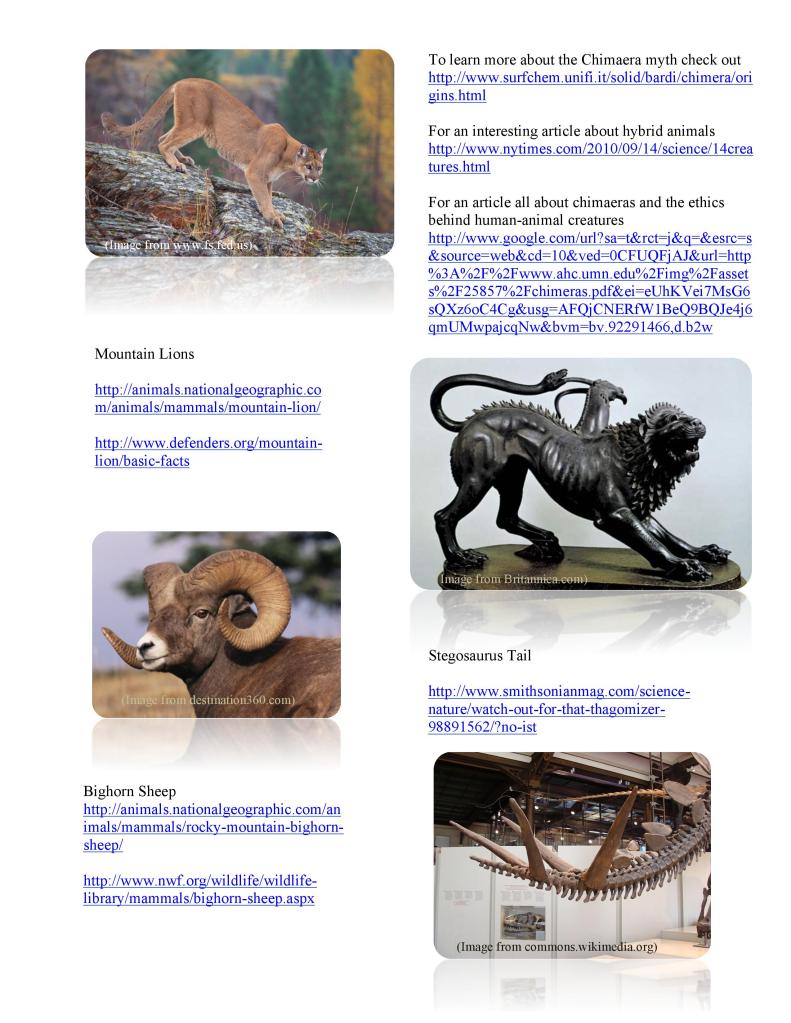Below is a list of cryptids created by students of Heidi’s Cryptids class. Enjoy!
April 5th, 2015
Early this morning at around 3am, a group of young adults were hiking the Bootjack trail of Mount Tamalpais to observe the lunar eclipse. According to their accounts, there was a loud, low scream that came from atop the mountain — it seems the sound was coming from the forest, somewhere on a flat above. The friends, worried it was a fallen hiker, trekked up the mountain to try and see if there was a person or animal in distress. After traveling about half a mile, the group came upon an ungodly smell — what seemed to be a mixture of alcohol, marijuana, vomit, and blood. Upon the forest floor were crushed cans of Coors Light and empty handles of Smirnoff Ice. The hikers also discovered what appeared to be bloody bones and remnants of male appendages. As they continued through the forest, the smell grew stronger with each step, until they came upon an open field. An ungodly sight was discovered — what appeared to be a massive creature was hunched over a small, bloody pile of something the hikers could not make out. The only thing they could detect were remnants of a Rockstar branded shirt and obscenely patterned basketball shorts.
After adjusting to the moonlight, the hikers saw what seemed to be a half woman half horse creature. It took a moment for the creature to notice the hikers — once it looked up, the group got a solid look. The ominous “thing” had a shiny black mane in what seemed to be the bottom horse half and almond tinted skin on the top human half. It appeared to be a feminine form — she had wiry, long black hair, piercing green eyes that seemed to stare into the hikers souls, and a mystically enchanting face. Moss covered her torso and fell delicately over the back of her mane. When she noticed the group looking at her, she began to walk towards them. The group was terrified but as she moved closer, she stopped and bent over slowly, bowing at them. Petrified, they waited for what seemed to be their untimely fate; it is then that she revealed her magnificent wings — about 15 feet wide, and flew away. The group ran down the hill, headed back to their car and sped directly to the police station.
No one has seen this creature since, but there have been rumors all about town of previous sightings in the past 50 years, which describes a very similar animal.
Artists rendering of creature described:
Geography and ecological setting
Legend says that CC resides on Mount Tamalpais in Marin County, California, where she exists amongst the redwood trees, living in harmony with the creatures of the forest. CC’s diet consists of herbivorous foods, such as berries, tree nuts, and foliage. She lives on a completely cruelty free diet — she does not see the murder of misogynists as anything but a gift to the Earth.
When in her physical form, she sleeps inside of the largest redwood trees, where she has carved a cave to lay inside of. The majority of these sleeping areas are as far from hiking or biking trails as possible, but when she feeds, she has to travel to areas where she is able to have human contact.
Evolutionary History and Biology
Old stories tell residents that a centaur named Agate, who lived in Eureka amongst her male-dominated Centaur tribe, was tired of being told what to do by the aggressive male centaurs. She was done being taken advantage of, being told she was not strong enough, and being cared for as though she could not hold her own. The brutal actions of the men in her tribe were no longer acceptable to her. So, after about 30 years of living with all the other centaurs, she left the tribe in Eureka and traveled alone to the reservoirs of Mount Tamalpais. She lived there alone for many years and existed peacefully amongst all animals and spirits of the mountain. As she began to age, she realized that she wanted a child to carry on her legacy of roaming free from the oppression of the male gaze. Soon after this realization, she met a great eagle, friend of the Miwok, who was named Spirit Amber — Spirit had the gift of being able to transform from hawk form to spirit form during moonlight tribal ceremonies. Spirit helped Agate to understand his mystic abilities, and Agate mastered the ability to harness her energies from crystals, though was unable to take spirit form during full moons. The two eventually coupled and CC was born — the fusion of the two creatures brought forth new abilities in CC, as well as an insatiable hunger to eradicate those who do not respect women.
The Crystal Creature, also known as CC, mainly takes the form of an unseeable spirit. She lives as an emanation of herself and her parents during the daytime and on moonless nights. All through the month, she harvests crystals from the mountain — mostly quartz, calcite, and serpentinite — and gains strength from their celestial energies. As the moon becomes full and she gains maximum strength from her crystals, she begins to take physical form. She is only fully formed as her mystical and divine feminine being one night of the year, on the full moon. On this night, she feasts. Using her enchanting and indescribable beauty, she magnetizes misogynists towards her. This pull can find misogynists from over 10 miles away. Once they are near, she stops all mystical mind-influence to allow them one last chance to stay alive. She takes the form of a woman sleeping on the floor of the woods, open and vulnerable. If they have offensive intentions, she can detect it — in that case, once they are close enough, she transforms back to her horse-human self and devours them alive.
What inspired the creation of this cryptid
The main inspiration for this cryptid was the centaur. One of the most common legends of the centaur is that they are known to pillage and rape, being destructive creatures. I wanted to have the feminist opposite of this creature, illustrated as a cryptid. Instead of representing a male centaur I created a female one which also kills misogynists, while the legendary centaur is a misogynist.
Another was that of a Native American hawk. The hawk is seen as one of the most powerful spirit animals in connection with the spiritual realm and one’s higher meaning — this adds to CC’s divine feminine personality, which provides here with the ultimate strength as an independent, intelligent and deadly female.
My final inspiration comes from the trope of the femme fatale. The femme fatale is a female character that is in most all Noir films and novels. She is known to be strikingly beautiful, but also deadly. I have studied Hard Boiled fiction this semester in another class, where I analyzed this trope and uncovered a disgusting truth — the femme fatale’s strength is only in her sexuality, which is an oppressive and misogynistic tool to use. This shows women that the only way they will be able to make any gains in life is through using their bodies. With CC, she does this, but in a twisted way — she lures misogynists in with her beauty, then consumes them alive. Take that, elitist male misogynist authors!
Links to learn more about the Centaur:
http://en.wikipedia.org/wiki/Centaur
http://monsters.monstrous.com/centaurs.htm
Links to learn more about the hawk spirit of Native American tribes:
http://www.spiritanimal.info/hawk-spirit-animal/
http://www.native-languages.org/legends-hawk.htm
Links to learn about the femme fatale:
http://en.wikipedia.org/wiki/Femme_fatale
———————————————————————————————————————————————
Napa Valley Register
Monster Living In our Backyard! by Heidy Garibay
Pink, water serpent, scaly, furry, sharp teeth, and spiky tail? It’s sounds like something from a sci-fi movie, but this creature could be living in our own backyard! Locals have named this creature pinky because of the color of its skin. During the past few weeks, we have had many calls and emails regarding a monster in Lake Berryessa. We talked to the Sheriff’s department, and they too have had a rise of calls regarding a creature seen up in Lake Berryessa. Many of us go up there to relax, have a BBQ, and swim in the lake. That will soon change. We talked to John “Johnny” Anderson, who says his wife Lindsay saw and touched this crazy creature. We tried reaching out to Lindsay, but she declined to comment.
The Anderson’s went to Lake Berryessa on Memorial Day, they were having a BBQ, having a few beers, and swimming in the lake. Lindsay Anderson was swimming in the lake when she saw a pink long thing swimming under her. She thought she was imagining things, so she kept swimming, all of a sudden, she felt something graze her leg. It felt furry, suddenly it wrapped around her leg and pulled her down. Her husband tells us that he heard her scream, and saw her submerge in the lake.
“We, were all having a great time, I was talking to Billy when all of a sudden I hear Lindsay scream. I saw her head go in the water and come up 3 seconds later. I thought she was playing around, until she was underwater for about 30 seconds. A bunch of us went in the lake to see what had happened to Lindsay. I saw a shadow of something swimming away from Lindsay, it looked to be around 10ft long. Lindsay came out of the water and could barely breathe. She had three small wounds around her ankle” Johnny told the Register with a trembling voice. “Lindsay cried, and cried, as she told me what had happened. She said it felt like something really furry was holding on to her. She was so scared, thought she was gonna die!”
Residents describe this creature as a serpent like creature that is about 5 feet long. It is pink and to the touch it feels very furry. It has very sharp teeth, and spikes coming out of its tail. It also has horns coming out of its head. It is rumored that the creature came to Napa after a science experiment went wrong!
There have been several similar accounts, from people how claim to see or been attacked by Pinky. Next time you’re out in the Lake be careful, or Pinky might get you.
Geography and Ecological Setting:
The Lake Berryessa Furry Monster, or Pinky for short lives in Lake Berryessa in Napa County. It has been spotted by many residents that go up to the Lake to have a good time. Lake Berryessa is common spot for residents to go camping, to have parties, and barbecues, especially during holidays and hot summer days. Lake Berryessa is a man made lake, and it is also the largest lake in Napa County. Pinky lives in Lake Berryessa, or people think it lives there because Lake Berryessa is believed to be haunted. Several people have died in the lake, so many residents believe the souls of those people are still in the lake. This is also the area where the zodiac killer spent a lot of his time. There are areas of the lake where people usually don’t go to, so it is possible that those are the areas pinky lives in, and he sometimes comes up to the shoreline. The shoreline is usually where he is spotted.
Evolutionary History and Biology:
Pinky breaks all the rules of biology, it is believed he came into existence when a sea serpent and an alligator mated. It is rumored that scientist found this rare creature in the amazon and brought it back to the U.S to study it. The creature started getting bigger and they decided to let it into the wild. The scientist picked Napa because one of the scientist was going to the Napa Valley on a wine tasting trip. He didn’t know much about Napa and thought that everyone in Napa only cared about wine so he figured no one would notice this creature in the lake. Since Pinky is a weird hybrid creature, and probably the only one of its species it most likely won’t be able to reproduce.
Pinky is a very odd looking creature, it is said to look smooth and scaly, but to the touch it feels furry. The Furry Monster is a 5ft long snake like creature. It has a pink complexion that looks slimy and scaly, but it is actually very furry. It has big bug eyes, and little horns on its head. It has very sharp and canine type teeth. It also has spikes coming out of its tail. It growls when people get too close to it. People are terrified of it because of its teeth and tail spikes.
What Inspired the Cryptid:
Many cryptids inspired me to create Pinky. I think the one that influenced me the most was Nessie. I have always been fascinated by Nessie, when I was younger I would hear stories of people who claimed to have seen it. I have wanted to believe that Nessie exists but, after reading Abominable Science by Loxton and Prothero, I now don’t believe in Nessie. There has been a lot of research done that proves why a creature like Nessie can’t survive in the Loch Ness. Nessie is the Famous Loch Ness monster that lives in Scotland, people describe it as a dragon or prehistoric looking creature that lives in the Loch Ness Lake. There have been numerous expeditions exploring the Loch Ness in search of Nessie. All these expeditions have proven unsuccessful, all the videos captured have been a hoax or just black footage. Sightings of Nessie skyrocketed after the movie King Kong came out. This was because in the film there was a gigantic long-neck water monster. (Loxton and Prothero). Many people describe Nessie as a plesiosaurus, but according to Loxton and Prothero a plesiosaurus even it managed to survive all these years cannot live in the Loch Ness. First of all, plesiosaurus is a tropical creature, so it cannot survive in Loch Ness. Secondly, there is not enough food for a creature of that magnitude. Third, it would have to come up to breathe, which means there would be actual pictures of it and people would be able to see it all the time. (Loxton and Prothero).
For more information on Nessie: http://www.nessie.co.uk/
Chessie of Chesapeake Bay also influenced my creation of Pinky. Chessie is a black serpent like creature that has been spotted in Chesapeake Bay. There has been numerous sightings of it and even video footage that still hasn’t been proved to be fake. According to Linda Godfrey, sightings of a 12 foot serpent like creature date back to 1846. There have been many sightings by reputable people even a CIA employee. In 1982 Robert Frew caught several minutes of video of Chessie. He and his wife were hosting a dinner party. Many of the guests also saw the mysterious creature. The video still hasn’t been proved to be edited or fake. (Godfrey)
For more information on Chessie: http://livingdinos.com/2011/07/chessie-the-chesapeake-bay-monster/
I also combined some of my fears when creating Pinky. I am not a big fan of lakes or oceans because there are many creatures that live down there that we cannot see, and that freaks me out. I am also incredibly afraid of snakes or things that slither. I decided to combine some of my fears into my cryptid as a way of making fun of them. I also did this by creating a very unique combination. For example a pink, fluffy, snake, how many times do we see that in real life? Using cryptids and some of my fears I was able to create a cryptid of my own.
______________________________________________________________________________________________
“Pygmy Odocoileus” Humanoid, by Hannah Ingwerson
Ethnoknown Evidence:
The following article was found in the Newspaper, “Minnesota Moospaper” released on July 14th, 2011:
“Holy Horns! Pygmy Deer People Found?!”
By: Hannah Ingwermoose
Reports were made early last week about a possible sighting of Pygmy beings who appear to be a mixture of deer and human. Dr. James DeSoto is a local floriculturist who is currently studying the Western Prairie Fringed Orchid in the Aspen Tall Grasslands in the Minnesota area. He is extremely familiar with the area spending time studying the macroecology of the surrounding region. On tuesday he came to us reporting something that none of us at the “Minnesota Moospaper” have heard of before. “It was unbelievable,” DeSoto exclaimed, “In my five years in the Aspen Grasslands I have never seen anything like it.”
DeSoto agreed to participate in an exclusive interview so that the readers could have a better understanding of what happened:
Can you please give the exact date and time of the event:
The event happened very early, I would say 5AM, on tuesday morning. The date was the 12th.
Why were you out in the Tall Grasslands so early?
Well thats when my day starts. I have to arrive early and organize exactly how my research will pan out that day. Plus, after studying these orchids for so long, I’m kind of a morning person.
Why these orchids, and why in the Grasslands?
The Orchids fall on the threatened scale of the conservation status. They are actually an endangered species. The Grasslands are one of the few places they can still be found, and even in that natural habitat they’re hard to come by.
So you would say you’re familiar with the area then?
Indeed, very familiar.
Please explain with as much detail as possible what happened Tuesday morning:
Of course, yes. Well my day started fairly normal. It was a clear morning, still a little chilly. The sun hadn’t fully risen but it was high enough in the sky that I could see the dew as it dripped down the petals of my cherished orchids. [Moose] it was such a beautiful morning and everything was going like it normally did, when I suddenly heard an incredibly [moose] bizarre noise. It was obviously some sort of young animal, and it sounded almost human but also strangely like a deer as it cried out to the open air. Something about it gave me [moose] chills. I began to head towards the sound, and the louder it got, the faster my heart began to beat. I tell you, I am well informed on the local fauna of this area, and god knows that the [moose] flowers were crying in the morning sunlight. Then, I saw something, and I can only begin to describe the way I felt. Out of the grass, a pair of tiny antlers, like the rack of a deer, appeared and swiftly began to move in the same [moose] direction that I was heading. Towards the cries of whatever the [moose] was there with me. So I ran too! I mean, what the hell would you do knowing that there was nothing in this area with antlers that could be small enough to stay concealed among the tall grass. So I ran, and let me tell you this thing was [moose] fast, and in my hurried panic, I tripped! As I fell to the ground I thought to myself “[moose], I [moosed] up,” I didn’t think there was any way that I would be able to see this thing. I missed my chance, my only chance. That was all I could think, but then I looked up. As I lie on my stomach, I looked up and I swear to you, I swear to [moose] God that right in front of me, frozen, staring directly at me, were two bizarre looking creatures. One was obviously the creature that I had heard crying earlier, and the other must have been its father by the way it stood defensively in front, though both were visibly shaking in fear. Now, I know I am going to sound [moose] crazy, but these little creatures were mini deer! But not just mini deer, they looked like mini people too! They were bipedal, standing on two, bare human feet. They stood like people, very upright, bones stacked. But in their faces they appeared as a dear. Long muzzle, fur with markings like a whitetail deer covered their bodies, but their arms and feet were bare. We stared at each other for at least fifteen seconds and then they both just took off! Ran right past me and into the tall grass where the bigger one with antlers had emerged. It was [moose] incredible. I still don’t fully understand what I saw, but I have decided I’m going to refer to them as the “Pygmy Odocoileus”. Which relates to the scientific name of the whitetail deer, Odocoileus Virginianus.
Do you think you’ve discovered a new species?
I think that…I have, yes. I think I’m going to be much more aware of my surroundings from now on. I think it may be time to focus my research on aspects of the ecology other than my orchids. I’m very interested in discovering exactly where all of this will go.
And where do you think it will go?
Come on, I’ve potentially discovered some new [moose] animal. Could they be some form of missing link in the evolutionary train? Who really knows at this point. All I know is, I know what I saw. They’re out there, I can promise you that.
Updates will be made about this fascinating cryptid as we receive them.
Geography and Ecological Setting:
The Aspen Parklands refers to a rather large area expanding from central Alberta, through central Saskatchewan, and expanding down to South Central Manitoba close to the United States border of Minnesota. It is a transitional biome between prairie and boreal forests. Groves of spruce, poplars and of course aspens are broken up by flat prairies and mingled with dense shrubbery, stream and river valleys. There are three main locations of the aspen parklands: Foothills, Central and Peace River. The largest is the Central Parkland. Together, all three span across 500KM.
The climate in this region goes through drastic changes depending on the season. The summers are short, humid, and hot. The winters are longer, and cold. This is a term known as Humid Continental. Groves of forests are able to survive because precipitation levels are lower than those found in boreal forests.
Where this crypid is found is in the most rare type of habitat found in this fusion of biomes, and it’s the tallgrass aspen parklands. It occurs only in the most extreme southeastern region, which flows into northern Minnesota. Although it is the smallest biome found in Minnesota, it expands across three provinces in Canada. This area is actually considered a conservation area and is home to quite a few rare species, and is home to one of Minnesota’s only wild elk herds. It is a place where animals well adjusted to harsh winds, extreme temperatures, and dry conditions thrive comfortably. A series of elemental occurrences allow tree groves, such as aspens, tall prairie grasses such as the Big Bluestem and wild flowers like the Western Prairie Fringed Orchid to grow. It is also home to quite a bit of farmland where cattle graze.
The tall grass lends itself as perfect camouflage for the Pygmy Odocoileus to hide and live comfortably. These creatures are not affected heavily by the harsh weather conditions because of their proximity to the ground. Strong winds do not pose any sort of threat. Cold weather will not affect them as they are covered in fur and travel in groups for comfort as well as safety. Hot weather is countered by the groves of trees offering coverage and shade. A lot of their water consumption comes from plants, as rain is not a common occurrence. This process is known as “evapotranspiration”.
Evolutionary History and Biology:
The Pygmy Odocoileus or Pygmy Deer evolved from the modern day Whitetail Deer. Harsh living conditions have caused the mini deer to make some drastic evolutionary changes. The largest is that the species is bipedal. It is believed that the creatures evolved this way for several reasons. It seems to be easier for them to navigate in the tall grasses when standing on two legs. Resources are easier to utilize with a strong upper body and supportive lower body. Their main food source is the leaves of the aspens, which they have to climb to get to. The trunk of the aspen tree is tall and slender and lacks low branches for them to grasp on to, meaning they have developed the muscular structure to shimmy up the tress. Although it seems like a hard feat, the Pygmy Odocoileus has developed hands with opposable thumbs, and humanoid feet with long toes to allow for climbing abilities, as well as easier navigation in the flat prairie land. Because of their bipedal posture, they have also developed a human-like skeletal structure, with shoulders, a forward facing pelvis, two knee joints and ankles.
It was, of course, over a lengthy period of time that all these changes were made. They are an advanced and intelligent species almost displaying human qualities. Although they do not dwell in the tall trees that have learned that off the ground is where food and sometimes safety can be found. Their small size makes for navigating in the tall grasses very safe and very easy. Typically, they have a muscular build and are surprisingly quick and agile on their human-like feet. The males still grow impressive racks of antlers, and it is believed that they are used for protection as well as a mating display for the females. They are still mainly covered in the fur/patterning found on their whitetail cousins, which acts as a form of camouflage among the tall grasses and flat lands.
As it was stated earlier, the weather does not overly affect these creatures. They have evolved to have a low proximity to the ground, which helps to provide an escape from the harsh winds that billow through the flatlands. They deal well in cold by staying huddled in the tall grasses. As well, during the cold seasons they grow thicker fur. In the warm and dry seasons they tend to stick to the shaded groves. Because the precipitation levels are so low in tallgrass aspen parklands, they get most of their water from the water that transpires from the local flora. Their small size adapted to this quite easily.
Some do not believe that evolution could have made all of those changes to such a small group. There are those who argue the government is involved. Others say they are the product of some sort of alien experiment. And, of course, there are those who say they don’t exist at all.
Cryptid Inspiration:
More than anything, I think I was inspired by my love of antlers for this cryptid. For a large portion of my life I have had a strange fascination with antlers. I am not a hunter and would not kill a buck for his antlers, but I do love the way they look. Beyond that, my biggest inspiration was honestly a character named John Mischief from a novel called “Abarat” by Clive Barker:
http://www.clivebarker.info/mischief1.html
As far as the monsters and mysteries go, I think I was most inspired by those cryptids who are known for being humanoids. The ones who are a blend of animal and human like qualities. A major example of said cryptid is:
“The Florida Gator Man”
Background:
I have read in Linda Godfrey’s “American Monsters” of reports made by an 18-year-old kid in 2012. He claimed to see a gator-man like creature lurking around the St. Johns River delta for the first time in 2010. The kid was working towards degrees in zoology and paleontology and was volunteering for the Florida paleontology museum. On several occasions he had an encounter with a creature he described in great detail. He claims the creature looked like a giant, fully grown male alligator, but with arms much larger, and longer, and with definite muscular tone. It also had heavily developed hind legs; broader and thicker. It had the ability to raise itself on to its hind legs and walk around with a slightly hunched over posture like that of a bear. The creature had a tail like that of an alligator and scales like that of an alligator, and coloration like that of an alligator, but its arms hung like that of a mammal. The face was still very alligator in appearance, with no lips and visible teeth. This creature would make hissing sounds coupled with a low grumble that sounded like an adult alligator, but deeper and louder.
On a website page I found (link provided below), it is claimed that reports of a creature like this have been made since the mid-1700s. Descriptions on the website are a little different from the claim made by the kid Linda Godfrey received information from, but the general idea is still the same. The website claims the creatures are close to five feet and travel in small tribes and have developed a language of sorts, or a way to communicate. On top of that, the page claims that these creatures may have developed the use of tools, which is a pretty unnerving thought. Apparently there is also a strange taxidermy creature that looks a bit like a hoax to me, but is kind of like a mummified mermaid/alligator/human hybrid.
http://www.americanmonsters.com/site/2010/05/gatormen-florida-louisiana-usa/
Inspiration:
I was most inspired by the body structure of the Florida Gator Man. The idea that he still has many of his gator features but can stand bipedal like a bumbling bear is an interesting quality. I think it makes the cryptid more interesting if it resembles a human because then it’s a creature easier to relate to. And in a sense, that makes the creature more of a mystery. How did this alligator become something so human? How did the pygmy deer become something so human? Are they related to humans in any way? The idea of human/creature hybrids causes me to think pretty heavily about the power of evolution. Both the cryptids still resemble the creatures they potentially evolved from, but have large differences are there too. Also, the Gator Man tribe mentality inspired me. I like the idea of finding a curious little creature so mentally developed that they travel in packs and use basic tools.
——————————————————————————————————————————————
Tahoe Tilly, by Ashley Farano
Image Drawn by Witness Amy Smith
Ethnoknown Evidence
An article from the “Tahoe Times” newspaper:
Lake Tahoe, Ca., July 15, 2014 – Lake Tahoe, a tourist destination for many, a place to enjoy recreational water activities in the safety of a lake; at least, that’s what people think. Legend has it that there is a large dolphin-like creature in the depths of the lake that surfaces to torment both locals and tourists, known as Tahoe Tilly.
The most recent occurrence happened while Amy Smith, a high school biology teacher and Tahoe resident, was paddle boarding about five hundred yards from the shoreline. Smith paddle boards every day, taking in the fresh morning air. Smith states that her trip started out like every other day. “I was paddle boarding out from shore as I do all the time. I did not expect anything unordinary to happen,” she said. Just as she got as far out as she wanted, she noticed something in the far distance partially jumping out of the water. “I thought it was most likely just a large fish,” she stated. What she saw was not just a large fish, according to Amy.
As she was moving along the shore, she noticed this creature getting closer and closer to her board. “I started to get a little nervous, but at that point I still assumed it was just a large fish that could not do any harm,” Smith stated. That is when the creature came barreling towards her and quickly circled her in the water. She caught glances of the creature that resembled a trout but had hair and teeth like a bear. Its dark fur was black with a bluish hue and appeared to be about ten feet in length. “I tried to remain steady on my board, but the water was getting too rough and I flipped off my board,” Smith remembers. When she was in the water, the creature gently pushed her around for a total of about five seconds and then swam away. It was evident that this creature wanted her to know it was there, or just wanted to play! “I was terrified until I realized that the creature was not trying to hurt me,” Smith said.
Since the beginning of the 1960s, dozens of people have had experiences similar to Amy’s in Tahoe’s waters. The creature that Amy Smith may have seen is commonly referred to as Tahoe Tilly. Many reports note the fur-like appearance on a fish-like creature’s body and the playful behavior. Photograph evidence has yet to be taken, mostly due to the fact that Tilly is spotted while people are performing recreational water activities. There is definitely a creature in these waters that people need to be aware of.
Geography and Ecology Setting
Tahoe Tilly is primarily spotted near the North Shore of Lake Tahoe and has also been seen during family and tourist boating trips. Lake Tahoe is 22 miles in length and 12 miles in width, reaching a maximum depth of 1,645 feet. The temperatures of the water average 40 to 50 degrees during February and March and warm to be 65 to 70 degrees during August and September. The cold water temperature is due to the rain and snow melt off which makes up 65% of the water. A third of this water flows into the Truckee River. Lake Tahoe has a water clarity of about 70 feet deep. It is highly likely that this lake is a home to multiple creatures that have not yet been discovered in science due to its massive size and extremely cold temperatures that make it difficult to explore the lake in its entirety.
Although the water temperatures are very cold, Lake Tahoe is still home to salmon and trout along with other species of fish. Due to the bear features that Tahoe Tilly has, this creature can eat the fish that are in the lake and will never go thirsty due to the plentiful amount of water that it is constantly surrounded by. It is seen mostly in the summer months because this is when tourists are out on the lake doing water activities. It is possible that this creature could live here due to the massive size and depths of the lake. This creature could adapt to the cold water temperatures and its fur prevents heat loss during the cold winter months like that of a polar bear.
Evolutionary History and Biology
The animals that this creature is biologically linked to are the bear and a fish that is about the size of a large dolphin. It is said that the Donner Ridge Fire that happened on August 20th, 1960 brought a lot of bears down to lake level to find shelter. One of the black bears that came down and managed to get in contact with a massive fish that is the size of a dolphin and it bit the fish causing it to develop some black-bear like qualities. This creature has been reported to be about eight to ten feet in length with a distinctive bluish hue on its black fur.
Tahoe Tilly is a fairly new creature; therefore, it does not have a huge amount of sightings compared to some other cryptids. The sightings for this creature began in the early 1960s, which leads people to believe that the theory of the bears coming down from the fire is correct. Eyewitnesses that spot this large creature from a distance usually do not note that there is fur due to the difficulty to see this detail from a far distance, but those who have seen the creature up close or have had an interaction with it primarily note the fur and large size.
What Inspired the Creation of the Imaginary Cryptid
- Tessie, The Monster of Lake Tahoe
The primary inspiration for Tahoe Tilly is from a creature that is also in Lake Tahoe known as Tahoe Tessie. When I was young, I went on a daily boat cruise that had a Tahoe Tessie theme. This large, serpant-like creature is said to be spotted during summer and has about a half a dozen sightings each year. Sightings of this creature can be traced all the way back to 19th century settlers and is discussed in Washoe and Paiute Indian tribe legends. It is described as having a smooth appearance with a serpentine body. This beast varies in color from black to green and has been said to be anywhere from 10 to eighty feet. It is said, but not proven, that in the 1970s, oceanographer Jacques Cousteau went down to explore the lake, but would not release any pictures or data stating that, “the world is not ready for what I have seen.” Lake Tahoe gets to depths of 1,600 feet, so it is very possible that there are creatures in this body of water that have not been explored in science.
I chose to take inspiration from this creature because this was the first time I had ever recognized the concept of cryptozoology. I did not know it by the name cryptozoology, but I recognized that this is a creature that had many sightings but has not been proven to exist. I was very young and I found the idea of this creature to be so fascinating. During the trip I had my eyes glued to the water looking for signs of Tahoe Tessie and I have never forgotten about this creature.
- http://www.weirdus.com/states/california/bizarre_beasts/tessie/
- http://www.weirdca.com/location.php?location=54
- Nessie, The Loch Ness Monster
I have always had an interest in lake monsters, so when we discussed Nessie in class I knew that I wanted my cryptid to live in a lake. Nessie is one of the most well-known lake creatures when it comes to the subject of cryptozoology. Nessie has been spotted hundreds of times in Lochness Lake in Scotland, although many of these sightings were reported after a Nessie-like creature appeared in the movie “King Kong.” Loch Ness is approximately 745 feet deep and 22.5 miles long and 1.7 miles wide. Nessie has two humps, a long tail and neck, and snakelike skin.
——————————————————————————————————————————————
The San Francisco Monacle
The Creature of Cow Hollow: The Antiphant
By Audrey McEachran
Saturday, March 21, 2015
Strange discoveries have kept the city of San Francisco, California buzzing with excitement over a creature that scientists are trying to learn more about. This creature, spotted on Ocean Beach, as well as some other places, has become an unsolved mystery to many people, especially the residents of San Francisco.
What is this mysterious creature called, one may wonder? It is called an Antiphant. According to the eyewitnesses, the Antiphant is a cross between a giant anteater and an elephant. It has big ears, a long trunk, wings, and a big, furry tail. It has the markings of an anteater and has a furry body. The Antiphant has only been sighted in San Francisco. Eyewitnesses have thought that it is an escaped animal from the San Francisco zoo.
Since the Antiphant flies at night, most sightings occur on late foggy nights, where the creature sweeps the skies and lands in trees. Antiphants are thought to eat leaves, hermit crabs, ants, and peanuts. It also appears that they enjoy spending time on Ocean Beach, where there are plenty of hermit crabs to feast on.
One eyewitness, Stephanie Smith, thought it was an escaped animal from the San Francisco zoo and proceeded to call animal control. By the time animal control arrived at the scene on Ocean Beach, a large portion of leaves from one of the trees were missing, as well as the Antiphant. Not believing this was anything other than a vulture, no evidence was collected.
In September of 1937, two Antiphants were seen on Ocean Beach across from the Dutch Windmill. While a heavy fog rolled in, the creatures were found lying on the beach, the ocean washing up against them in the foggy moonlight. When approached by a couple named Claire and Arthur Richards, the Antiphants became startled and disappeared into the foggy sky. Jose recalls the sighting, “I couldn’t believe my eyes. This furry, long-trunked creature with huge ears resembled a cross between an elephant and an anteater, and it also had wings. Claire and I approached it very slowly, but it became startled and took off into the air. We ran to where it had been laying and found hundreds of empty hermit crab shells. I don’t know what it was, but it sure wasn’t anyone’s pet.” Jose and Claire were staying at the Cow Hollow Inn, which is located on Van Ness Street. Since this sighing occurred, the animal has been known as “The Creature of Cow Hollow”.
Since the famous landmark sighting of 1937, where the Antiphant was dubbed “The Creature of Cow Hollow”, there have been other sightings in other areas of San Francisco.
Sam and Julia Hutchins, who were visiting Muir Woods and touring the site, reported seeing an unidentified creature in the woods. According to Julia, “Sam and I saw a giant animal when we were hiking in Muir Woods. We could not get a very good look at it, but it was huge! I’m not sure what it was.” Sam chimed in, “I’ve never seen anything like it. I just saw a big animal with wings and a big, sweeping tail. All of the sudden,” he continued, “it took off flying and disappeared.”
According to Jeremy Walker, a zoologist who works at the San Francisco zoo, he saw a few rather strange looking creatures lurking around the animals’ habitat. Jeremy works with the giant anteaters. “One day on the job,” he explained, “I saw these two creatures hanging around near our giant anteaters. It was obvious that they were not just anteaters. They looked like some type of interesting cross-breed. They had long, large trunks and thick fur. The creatures resembled both anteaters and elephants. But they also had wings, which was really strange. I have never seen anything like it.”
For security purposes, the San Francisco zoo has security cameras, and the creatures were caught on camera, trying to befriend the animals. Footprints were also discovered at the zoo. The footprints are undergoing further scientific investigation. Jeremy, as well as other staff members at the zoo, described the footprints in the same manner: “They looked like elephant footprints, but it was clear that the animal also had claws. Our staff is trying to determine what type of creature this is.” Just as before, the Antiphants flew off the moment they realized that they were being watched by people.
Elizabeth and Andrew Tinley, who were also at the zoo the day that Jeremy spotted the aardvark relatives, stated that they saw the Antiphants scouting around outside of the zoo, looking for ants to eat. They had also seen the creatures interacting with the giant anteaters and were confused as to why the creatures did not have their own area in the zoo. “It seemed like these animals were just going for a stroll through the zoo, which is something that people do, not animals,” describes Elizabeth. In the classic Disney movie Lady and the Tramp, it does not seem totally out of the ordinary for animals to drop by the zoo for a visit. When I mentioned this to the couple, Andrew said, “But this is real life, not a movie!” If a flying cross between an elephant and an anteater can exist, then maybe we need to change our view of what “real life” truly is.
Geography and Ecological Setting
The Antiphant has been sighted only in San Francisco. It has been seen in different areas of the city: Ocean Beach, where it likes to feast on hermit crabs, and the San Francisco zoo, where it tried to make friends with the giant anteaters. It is thought that the Antiphant’s main habitat is in Muir Woods, where there is a large abundance of ants to eat and leafy green trees. The Antiphant is thought to be able to hide in the trees, since it has wings. The trees have to be big enough to hold the Antiphant, though. The woods would be a good place for the creature to hide. Muir Woods is a very peaceful area, and the Antiphant is a peaceful creature, so it fits right in with the woods. The Antiphant is believed to have migrated from Central America or South America. It most likely migrated up the coastline and ended up in San Francisco.
Evolutionary History and Biology
The Antiphant is a cross between a giant anteater and an elephant, and it also has wings. It is thought that the Antiphant came into being while a giant anteater was migrating up the coast from either Southern or Central America around the late 1920s or early 1930s. Since elephants are present at many zoos, a giant anteater may have snuck into one of the many zoos, found an elephant attractive, and mated with it. This would describe the large ears, big trunk, and bushy tail that the Antiphant has, as well as its claws and anteater markings. It is unknown how the Antiphant developed its wings. The development of its wings may be an adaptation to the environment, because the creature appears to be pretty shy. Maybe it got its wings from an ostrich, but no one knows for sure.
What Inspired This Cryptid
This cryptid was inspired because of my love for elephants and anteaters. Elephants have been my favorite animal to visit at the zoo since I was a little girl. My parents and I would visit the Oakland Zoo often. I wanted to visit just to see the elephants. That was the highlight of the trip for me. Since my elementary school years, I have always thought that anteaters were cool. My love for anteaters began when I saw an animation of an anteater and was curious about it. Combining an elephant and an anteater seemed like a good idea, since I love both species. I got an idea to make the Antiphant fly, which made sense because it is a shy creature that tries not to spend much time around humans.
According to the World Wildlife Foundation, The elephant is the biggest land animal on our planet (World Wildlife Foundation). Elephants’ weight ranges between 4 and 6 tons, but an African elephant may weigh 8 tons (WWF). African elephants have tusks, but only some Asian male elephants have tusks (WWF). Elephants use their trunks for drinking water and bathing themselves, and they can pick up objects with their trunks as well (WWF). Male elephants typically live by themselves, because the elephant herds are led by females (WWF). A herd is usually led by the oldest female (Defenders of Wildlife). They mostly eat bamboo, different types of leaves and grasses, bark, roots, and crops that are grown by farmers (Defenders of Wildlife). Elephants are currently faced with the problem of loss of habitat (Defenders of Wildlife).
Anteaters do not have teeth, but they have a tongue that they use to eat ants and termites with (National Geographic). On average, anteaters devour 35,000 ants and termites per day (National Geographic). Anteaters are not able to find their food by sight, because they cannot see very well, so instead, they use their sense of smell (National Geographic). “The anteater uses its sharp claws to tear an opening into an anthill and put its long snout and efficient tongue to work” (National Geographic). They live in Central America and South America, where there are many grasslands and tropical forests, and they usually live alone (National Geographic). A giant anteater is usually between 5 to 7 feet long, and it weighs between 40 and 100 pounds (Smithsonian National Zoological Park). They have gray fur that is dense and coarse (Seaworld Parks & Entertainment). It is unknown how many years the anteater can live in the wild, but in captivity, it can live to be 26 years old (Seaworld Parks & Entertainment).
Learn More About Elephants:
https://www.worldwildlife.org/species/elephant
http://animals.nationalgeographic.com/animals/mammals/african-elephant/
http://www.defenders.org/elephant/basic-facts
Learn More About Anteaters:
http://animals.nationalgeographic.com/animals/mammals/giant-anteater/
http://nationalzoo.si.edu/Animals/Amazonia/Facts/fact-anteater.cfm
http://seaworld.org/animal-info/animal-bytes/mammals/giant-anteater/
____________________________________________________________________________________________
Doug, the Octosnalephant, by Macenzie Campolito
It was a cloudy day and though there was much to be said about the group of second graders at the tide pools on the sunniest day in the middle of April. It was a field trip for Miss. Fox’s science class at Sand Dollar Elementary School and the students were gathered amongst the slippery, algae covered rocks for a generic analysis of what lives in the shallows of the Pacific Ocean off the coast of San Diego.
The creature in question came to be known as “Doug” and that is how he shall be addressed for the remainder of the article. It was something that the teacher could only identify as a sea snail but to the children there was a completely different interpretation. It had the head of an elephant, arms like an octopus and a body that be retracted into a shell on its back. The more clever students decided to call it an Octosnalepant (oc-to-snel-ephant).
Many of the children had an interesting theory as to why only they could see the small tentacles and elephant features, one that made some sense even to this experienced writer: “When Doug is inside his shell, the only parts of him that are seen are his ears and trunk and that makes him look like a sea snail. He knows what a kid picks him up because he has special feelers that detect youngness because he too is young. Doug was only a baby.” Quoted from a very vibrant seven year old named Cleo. Cleo and her classmates, all of whom touched the creature when Miss. Fox was not looking, were adamant that Doug was one of many and that eventually graduate from the tide pools to the grander ocean.
Not only is it rather terrifying to imagine that a large Octosnalephant (or many) do roam our oceans but it is more endearing to know that it might only be known to children. Why is that the case? Will it ever be properly identified? Is this a classroom hoax and the teacher had agreed to remove herself from? The only true test of fact will come from the future child scientist that is yet to join the biology bandwagon. Will Doug the Octosnalephant come to be known one day, because to this group of second graders he is very real.
Where can it be found?
The Octosnalephant is generally found in the tide pools of warmer waters. The most sightings have been at very populated areas in San Diego, locations like Point Loma and La Jolla. Although these creatures are also found on most coasts with enough rich water life to allow any kind of camouflage. They are found everywhere and because of that it is curious that they have not been found. These cryptids are very conspicuous creatures, but we are lead to believe that they are drawn to very popular locations because they like human interaction. These tide pools and coasts are visited by field trips and many families from around the world and at any season. The assumption is that the shells of these young octosnalephants blend in well with the shells of sea snails and hermit crabs. Because tide pools already offer a lot of diversity of sea creatures, it is no wonder that this is where they choose to dwell, however there are very rarely any bigger than palm sized in the tide pools so the real mystery is if these creatures die that young, or get larger and simply relocate to the caves and larger dwellings in the ocean.
Evolution:
This cryptid creature was created through a slow process of a sea snail and an octopus. An Octosnalephant slowly became the snail with a lot of tentacles, then somehow, an elephant ended up near the ocean coast on the night of a storm. The poor elephant got lost, ended up in the tide pools. Just as the elephant was about to step down and crush the Octosnail, a bolt of lightning came from the heavens, bolted through the cranium of the elephant and ended in the shell of the Octosnail. It was a slow process but eventually the main body of the Octosnail began to grow ears and the tentacles turned into trunks. These creatures retained the intelligence of the elephant, the dexterity of an octopus and the ability to retract most of its body into the snails shell. This is a one of a kind creature that is hard to track down, especially because it only makes itself visible to children.
The Inspiration:
The real cryptid that inspired me came from a link that I found on Pinterest. Upon further investigation I learned that it is called an Octophant and it known in Europe through music. It has never been seen by a human soul, as its website says, but it is something that was really interesting because I have always had a personal adoration for both elephants and Octopi. This was created by an artist with an idea and it really caught on after he started to sell the Octophant on a screen print. In all, I didn’t really want to uee someone else’s idea, so I added a shell to the top of it and called it done. There are a lot of really cool snail and Octopus cryptids that I later took some influence from.
The Grootslang is half snake and half elephant that used to like under water, it was from an episode of The Secret Saturdays. It was said that this creature misbehaved and because of that it got separated and then created the snakes and the elephants. These are originally from South Africa and live in the swamp areas, the show depiction is rather an elephant type thing with a really long, snake like tail. There is a lot to be said about this creature in my mind, but this creature made me think of elephants with long appendages, which led to me thinking, again of an elephant with tentacles.
Another big creature, of course, is the Kraken. A Giant octopus made me think of something, in a way, that I didn’t want. I have always wanted something really little for my cryptid. The reason that I made these Octosnalephants so small is because I have always wanted an elephant that was so small and cute. I don’t actually know if these creatures grow up to be bigger than a palm sized thing, but I know that until I know for sure they will remain small.
One of the most bizarre inspirations that I thought of was the Sarmatian Sea Snail. This is part snail, with antlers and paws. And it is huge. This creatures looks intimidating but is known to be playing amongst the rocks at high tide and I really liked the idea that something looks scary, but is really nice.
I know that seems like a lot of inspiration, but the more research that I did, the more interested that I was. I learned a lot from these inspirations.
——————————————————————————————————————————————
Flibbertigibbet, by Lindy Cena
Description:
Small, delicate, soft, and of a variety of gentle pastel colors the Flibbertigibbet is, in appearance, harmless and adorable. However, as we all know, appearances can be deceiving. Faced with a misogynist the Flibbertigibbet, about the size of a volleyball, unhinges its jaw, in a similar manner to serpents, and can stretch its mouth to swallow a fully grown man whole. With a throat lined with concentric rows of teeth the Flibbertigibbet completely shreds its prey for easier digestion. Its long legs, which have been described as chicken-like, allow it to run at incredible speeds, up to 30 MPH! This creature has been spotted far and wide, from bustling urban areas to remote mountain towns, anywhere that there is a misogynist lurking the Flibbertigibbet can be found to serve justice. Atop the Flibbertigibbet’s head, right between its endearingly large eyes, rests a gemstone in the shape of a vulva. Once the misogynist has been consumed, the Flibbertigibbet uses this stone to alter the memories of those who could expose it to the larger world, leaving only a vague memory of an innocent looking fluff-ball. However, when faced with both a misogynist and a feminist the Flibbertigibbet will leave the feminists memory intact, which is how we have come to know of its true powers. Due to the memory adjusting properties of this creature it has evaded widespread knowledge of its existence. It is only through the stories of people who have seen it in its innocent, non-misogynist-consuming, form or the few feminists (that have seen it in its true form) who have come forward, that we know of its existence.
Ethnoknown Evidence:
Official Report
| March 10, 2015 was a day like any other in The Friendly City, a morning nestled in fog making its way to a warm sunny afternoon. At 2 p.m. Mary Gallagher (21) and her boyfriend of two years Sky Corrigan (22) were walking home along the Copeland Creek trail after a morning of classes at Sonoma State University. The couple was engaged in a deep conversation about a poor grade Corrigan had just received from one of his Women’s and Gender Studies classes, “ranting,” according to Gallagher, “about how the professor was only giving him bad grades because she hated men who challenged her.” Just after they passed the Snyder Lane intersection, things took a turn for the bizarre. According to Gallagher, there was a “strange flash of pink” off to her right, near the creek, that startled her enough to let go of Corrigan’s hand and turn towards the creek to investigate. When she turned back around to ask her boyfriend if he had seen anything, he was no where to be found. Instead, standing approximately where Corrigan should be was a “volleyball sized pink Chinchilla thing with big, sweet, eyes | and chicken legs.” She stared transfixed at the creature for a few seconds before it took off running at an alarming speed into the dense foliage of the creek. It is presumed by local authorities that this hallucination is a signal of something more deeply ingrained in Gallaghers psyche, according to the sheriff we spoke with “it sounds like the flippant imaginings of a willful young woman…I mean, what would you call a creature like that…a flibbertigibbet?” Sky Corrigan has not been seen since this incident and his family is offering a reward for any information surrounding his disappearance. Mary Gallagher is being held at the Sonoma County Behavioral Health Center as person of interest in Corrigans disappearance as she was the last person to see him. If you have any information regarding to this incident please call the Rohnert Park Police Department. |
Unofficial Report
| This report comes from an un-named source. Like any other journalistic endeavor Nude Politics respects the confidentiality of its contributors when asked. On March 10, 2015 the informant was walking along the Copeland Creek Trail around 2 p.m. some distance behind the now well known Gallagher-Corrigan couple. Having just gotten out of a WGS class with Corrigan, the informant stressed his repeated misogynistic behavior in regards to the class material: “it wasn’t, like, always super overt misogyny, but you could tell he definitely had a problem with the material and a problem with women in general. He would always cut me off, it was maddening.” As the informant was walking behind the couple, just after the Snyder intersection, they noticed a flash of pink off to their right. As they saw Gallagher turn to investigate they saw something truly baffling; the fluffy, pink, volleyball sized creature described by Gallagher in official news outlets appeared in front of Corrigan, proceeded to open its mouth to about the size of a man, and swallowed him whole in an | instant. Once Gallagher turned around the informant said that “a bright pink gemstone that, I swear, looked just like a vagina” emerged between the creatures eyes and “it looked like Mary was transfixed by it.” When asked why they didn’t come forward to the local authorities with this information the informant said that they knew everyone would think they were insane: “people already look at me like I’m crazy just for being a feminist, if I told them this they’d lock me up just like they did Mary.” At Nude Politics were are confused as to whether we should fear or praise this apparent misogynist eating creature that authorities have apparently deemed the “Flibbertigibbet”, so we’ll just leave it here for our fellow feminists to decide. |
Geography & Ecological Setting:
The Flibbertigibbet has been encountered in many different geographical and ecological setting. From rural farmland to the most bustling of cities, wherever misogynists can be found, so too can the mysterious and elusive Flibbertigibbet. While it is a highly adaptable creature, the Flibbertigibbet does have a few demands of its habitat. As aligned with feminine energy, the Flibbertigibbet must be able to be one with natural settings. It is crucial for the Flibbertigibbet to connect with nature on the full moon, in order to restore their feminine energy. This can prove difficult to the city dwelling Flibbertigibbet, but their long, tireless, and speedy legs allow the Flibbertigibbet to escape and connect with mother earth for a couple hours a week at least. The Flibbertigibbet likes to sleep in small alcoves, caves, or in that space between the garage and the house. Since their diet depends on a ready supply of misogynists, the Flibbertigibbet rarely goes without a meal. However, sightings have reduced exponentially in Sweden since the government their started making woman conscious laws and regulations. The Flibbertigibbet, like women, doesn’t poop, therefore there has been little to no physical evidence of their existence. The Flibbertigibbet is hydrophobic, it has been postulated that this is due to the down like texture of its body hair, which means that they cannot access seafaring misogynists such as certain Navy-men/women. When not out hunting for misogynists, the Flibbertigibbet spends most of its time lounging in the sun or watching from its cozy cave-like dwelling as it rains or snows.
Evolution & History:
It is said by some evolutionary scientists that the Flibbertigibbet must have a common ancestor with the Chinchilla. Given the softness of chinchillas fur, the rotundness of their bodies, and the overwhelming adorableness, it is clear that they are biologically linked. Somewhere back in the prehistoric era there must have been a coupling between the (larger) chinchilla ancestor and an ancestor of the chicken or possibly the ostrich given the Flibbertigibbets leg length. The main issue that people have with believing in the Flibbertigibbet is that it seems to possess mystical powers. However, historians specialising in the events of the Salem Witch Trials have claimed that these powers were bestowed on the early Flibbertigibbet by one of the few women burned at the stake who actually happened to be a witch. Understanding that most of the women being accused were innocent of witchcraft and only guilty of trying to be independent humans, this witch cast a spell that would cause the Flibbertigibbet to hunt down and eat misogynists for the rest of time. Or at least until misogyny had been eradicated from the human population.
Cryptid Inspiration:
The Flibbertigibbet was inspired by my Women’s and Gender Studies education and my obsession with Harry Potter. As an active student engaging in feminist theory I have spent a lot of time recently exhausted and disturbed by the state of society. I am particularly pissed off at misogynists and the way that they almost all adimately reject that they are, in fact, scum. I wanted to create a cryptid that would solve this problem for me, but with all of the adorableness I could imagine. The other inspiration was thanks to the Pygmy Puff or Puffskein from the Harry Potter series. These creatures are adorable fluffy balls, the pygmy variety being small and multi-colored, that have large eyes and roll around. I have always wanted a Pygmy Puff and so I figured I should create an awesome feminist version of the little buggers. I also drew some inspiration from the Sarlacc from the Star Wars series. The Sarlacc, for those of you nerds who don’t know, is the giant pit of teeth that various people are thrown into. It is made up, at least the visible aspects as most of the creature is underground, of concentric circles of teeth that devour its prey.
Cryptid Inspiration Links:
http://everydaysexism.com/
http://harrypotter.wikia.com/wiki/Pygmy_Puff
http://harrypotter.wikia.com/wiki/Puffskein
http://starwars.wikia.com/wiki/Sarlacc
———————————————————————————————————————————————
Jeweled Pygmy Afropavo
Small bird like creature that can move its wings like arms
Written by: Teresa M. Sousa
Location: Spring Lake, Santa Rosa, CA
Time: Saturday, March 8, 2015 most recent sightings but known to the surrounding neighbors for the last 30 years and possible native legends of a magic bird.
Recent sigting at Spring Lake stirs excitement among Local Cryptozologists
Early in the morning on Saturday, March 8, 2015, a two local Santa Rosa women were taking their weekly walk at Spring Lake. Much to their surprise they encountered a strange bird like creature that they have never seen before. “We were just on our walk” the first woman said, “when what I thought was a bird came flying right toward my face. I seemed like it was a bird flying to try and get away from something chasing it. As it came toward me I put my hands up and swatted at it. I hit it and it fell to the ground.”
What the two women described next may sound hard to believe, they themselves are having a hard time believing it. They described what they saw and at first glance thought was a small bird or hummingbird like creature. They said it was only about five inches in length. However the way it moved wasn’t like any bird that they had ever seen. “I know this seems crazy” the second woman reported “but I know what I saw. After my friend swatted it to the ground that is when we realized it wasn’t just a bird. It was a bird like creature but its movements were very human like. It flew back up into my friends face and then started shaking it’s wing at her and chattering. It looked like it had hands at the end of its wings”.
The women described the creature as being a blueish, green color with some dark purple in the feathers on its wings and tail. They said that its head appeared to be rather large but could not agree on if it had a large head or extra feathers on the top of its head. Both women described the body and the face as looking featherless but that it had scales that with the same coloration as the feathers.
Many of the local cryptozoologist in the area, including a student from Sonoma State, Teresa Martinez-Sousa, have been out on the hunt for the creature. This, according to Martinez-Sousa, has not been the first sighting of this creature that has been seen up at Spring Lake. In the last ten years or so many of the surrounding neighbors have made reports of a strange, very small, colorful bird. Martinez-Sousa says that she has been working with the local fish and game warden to try and figure out what the creature is.
We tried to contact the local fish and game office and they declined to comment. Martinez-Sousa said her impression is that the Fish and Game Department believes it is just a tropical bird that was probably someone’s escaped pet. Martinez-Sousa said there is only one reported story that she can find of an escaped exotic pet and it was reported in the neighboring county of Napa.
About 50 years ago a local couple imported a rare Congo Peafowl. The peafowl itself wasn’t discovered until the 1930’s, by Dr. James Chapin, who at the time was searching for another elusive animal called the okapi.
The Congo peafowl is much larger than the creature most eyewitness described but does have some similar colorations. It is a close relative of the peacock. Martinez-Sousa said that it is possible the bird mated with a smaller local bird species, and produced a sub-species.
“The truth is we are just not sure what is out here” she said, “but whatever it is we all want to be the one to discover it. From how its coloration has been described by the eyewitness’ it sounds like it could be related to the Congo Peafowl. I am going to call it the Jeweled Pygmy Afropavo.”
Afropavo is the genus of the Congo Peafowl. If the sub-species really exists it will have origins from a region that is known by many crypto-zoologists as “a veritable hotbed of cryptid activity”, the African Congo. The Congo is known for the sauropod-like cryptid the Mokele-Mbembe and the Mbielu-Mbielu-Mbielu, or the Congolese water monster with ‘planks’ on its back.
Martinez-Sousa was not the only expert up in Spring Lake searching for the creature. She is joined by a many others, including, William Montero, a local city official who is also a self-appointed, cryptozoologist expert. Montero said he has been a number of cryptid expeditions looking for Bigfoot, the Michigan dog man and Batsquatch.
According to Montero he has been blogging about this experience and posted announcements on various cryptozoology websites.
“This could be great for Santa Rosa tourism” he stated, “people can come and visit, do some cryptid hunting, have a glass a wine and eat some amazing food. Santa Rosa is a beautiful place but our tourism has struggled to rebound after the down turn in the economy. I am hoping that this will spark even more interest in the Cryptozoologist community and generate some tourist.” Whatever the reasoning for searching for the creature, many will agree it has generated quite a stir.
———————————————————————————————————————————————
The Amazonian Stone Lizard, by Ben Teurlay
crarovingiwillgo.wordpress.com
Natives of the Amazon have told stories for thousands of years of a giant lizard that lives of the heart Rain forest. This giant lizard can change from a 25 foot long colossal beast to a statue in the blink of an eye. Many say its protector of the peace and others say it’s a warning to fend off those who hope demolish the trees. Until yesterday, these legends were seen as a nothing but environment lessons.
On May 1st 2015, in Brazil Edward Wood, the head of logging company Wood Bro’s had the first encounter with the Stone Lizard in centuries.
“It was about 11:00 P.M. and I was out with a couple of the boys. We saw this lizard statue about the size of small car. We started dancing on it and next thing I knew I was the ground. A few yards away I saw this green lizard that was the same size and shape of the statue. It hissed at and me and ran off out of sight.”
The two workers with Wood told similar stories. One worker named Freddy Fibage trembled throughout his explanation of what happened that evening. Fibage said, “I’m leaving the logging business and moving back to my parents. This is not what I sighed for.” Most workers in the company are reluctant to by the stone lizard tale but makes you wonder if there is any truth to this old myth.
Geography, biology and history:
The stone Lizard legend here been told throughout the amazon region including Brazil, Peru, and Colombia. Statues have been made throughout these countries as a tribute to the creature. The first recorded account of the Stone Lizard was in Brazil and this is also the country with the most sightings. 60% of the amazon rain forest is in Brazil however 80% of the 54 recorded sightings were in Brazil.
The creature was mainly seen in the 1500’s and 1600’s when Europeans first started to export resources from the amazon. The creature supposedly killed around 52 Europeans in this time period and there were around 200 recorded sightings mainly by natives. Most historians believe that the Stone Lizard was a hoax created by natives to kill off Europeans with little to no consequence. Records from 1614 state that footprints were been found of the creature. since there are currently so many Stone lizard tribute statues many believe that some sightings are due to paranoid Europeans.
If the legends are to be believed, the stone lizard is a descendant of the chameleon. As a chameleon blends into its environment, the stone lizard is from a part of the amazon that that has many rocks. The stone lizard many not be made a real stone but rather be able to change from a light green color to a light brown to blend into its environment. Over time the stone lizard grew from a median size lizard to a 25 feet long.
What Inspired Creation of this Imaginary Cryptid:
The inspiration for the stone lizard the stone dragons named Mushu from the movie Mulan. Mushu is a stone dragon that is awakened to protect Mulan on her quest. Mushu begins the movie as stone but is brought to life by Mulan’s dead ancestor’s spirits. Mushu is considered by Chinese folk religion to be a tutelary deity. Tutelary deities are spirit that live in rock form. Often tutelary deities are seen as protector, much like the stone lizard. Guan Yu is a form of tutelay deities that the Chinese believe represents the spirit of a person of greatness that has died and remained in both the past and present. This idea was both the inspiration for the stone lizard but also the inspiration for Mushu.
http://cec.vcn.bc.ca/rdi/kw-gods.htm
http://en.wikipedia.org/wiki/Tutelary_deity
———————————————————————————————————————————————
Flutter Fly, by Taylor Zavala
Like many small beach towns, the town of Bolinas in Northern California is one worth the visit, especially if you enjoy hiking. Many come to hike the beautiful 8 mile trail known as Almere Falls to witness not only the beauty of mother earth, but also to see how magical the last part of the trail is. After hiking for what may feel like ages, the traveler will come to what should be known as heaven on earth. The end of the trail comes to a waterfall that runs down multiple levels of land and ends by falling off a steep cliff into the ocean. The plant life around the waterfall is incredible, with various shades of green and water lilies blossoming everywhere. Though the circumference of the area is not very large, it is a sight to see.
According to the few brave travelers who have stayed at Almere Falls way into the early hours of the night, it has been said that you can hear the quiet singing of multiple creatures all in unison. What are these creatures you might ask? Here is a tale from the first known report of these creatures.
Abel Catteli and his younger sister were sitting on the edge of the cliff at Almere Falls around 2:30 am one late summer night in 2011 when his sister became startled. She explained to him that she had heard a noise that didn’t sound like any other. As she listened closer she realized that the noise was not scary in the slightest bit, but in fact it was slightly soothing and even brought her instant joy she had not felt in a very long time. She looked around but all she saw were what seemed to be a large group of fireflies fluttering close to each other. After getting up to walk towards the glowing mass, she stopped because she noticed with every step, more and more would fly away and the singing would get quieter.
In September of that same year, Rick Saloman was hiking alone along the falls and slipped and fell. After what he says was two or so hours of being knocked out, Rick said he woke up and noticed very small creatures surrounding his body. These creatures were flying in a circular motion, singing a quite tune he could not make out. He said the creatures were so small that it felt as if he was looking at the stars in the sky, except they were right in front of his face. As his vision and his strength slowly came back, Rick stood up and all the creatures flew away. He said he was surprised that he was not in pain from the fall, but in fact, he felt better then he had prior to falling. He said it felt as if his body had been cured from all pain he had felt before. Rick has returned to the sight of his fall many times, in hopes of finding these tiny healers but has yet to see them again.
The Flutter Fly is a cross between a mocking bird and a firefly. Though it looks very close to a mocking bird, the flutter fly comes in various bright colors. Not only this, but after the sun has gone down, the flutter fly becomes translucent and glows in the dark, looking much like a firefly. The Flutter Fly is not much bigger then half the size of a quarter, making them relatively small and hard to see with the naked eye. They live behind the waterfall, sleeping during the day and coming out during the night for their protection. The other birds that surround the falls during the day hunt them for food, so they have adapted to only being awake during the evening and early hours of the night. The Flutter Flies travel in groups because they are unable to survive on their own. They are very dependent of each other in all aspects of their short lives (which is only about 7-12 months long) from finding shelter, finding food and healing. In fact, the main purpose of the flutter fly is to heal those (human or not) of any pain they may be dealing with, physical or emotional. They sing a quite song that sounds much like hymns, that grows louder depending on how drastic a healing session may be. When the flutter flies move together in a circular motion they let off a very light dust that will lie on top of what needs to be healed. The dust then soaks into one’s pours and creates a shield, allowing for the body to work twice as fast to heal itself.
Though the flutter fly has never been captured, it is known as the “tiny healer” throughout Bolinas County. Though there are very few reported interactions with these tiny creatures, many have said they venture out to the falls late at night in hopes of finding them, in hopes of finding healing. These tiny creatures have made a statement throughout Northern California. Many come to this place to pray and meditate, believing that the earth here is now blessed and gives off good spirits to those who walk the grounds of the falls. The town around the flutter flies has continued their good work by creating more places of worship, more places of healing, and even spiritual grounds. The natives of Bolinas have come together to change the town for the better and to even mark Almere Falls as a place of worship due to the mythical powers of the flutter flies.
I have chosen the flutter fly as my mythical creature for a few reasons. Throughout of semester, we read a lot about creatures that terrorize and harm humans simply for sport. I wanted to creature a creature that did the opposite, a creature that’s main purpose was to spread health and well-being to those who came in contact with it. I also chose to make my creature small, unlike most of the creatures we have talked about also. I do not have any creature to cryptid to compare the flutter fly to because I wanted to create a new cryptid, one that is praised, a cryptid that people do not venture to capture, but venture towards it for a better life. I would even say the flutter fly is kind of like the “holy grail” for cryptids.
———————————————————————————————————————————————
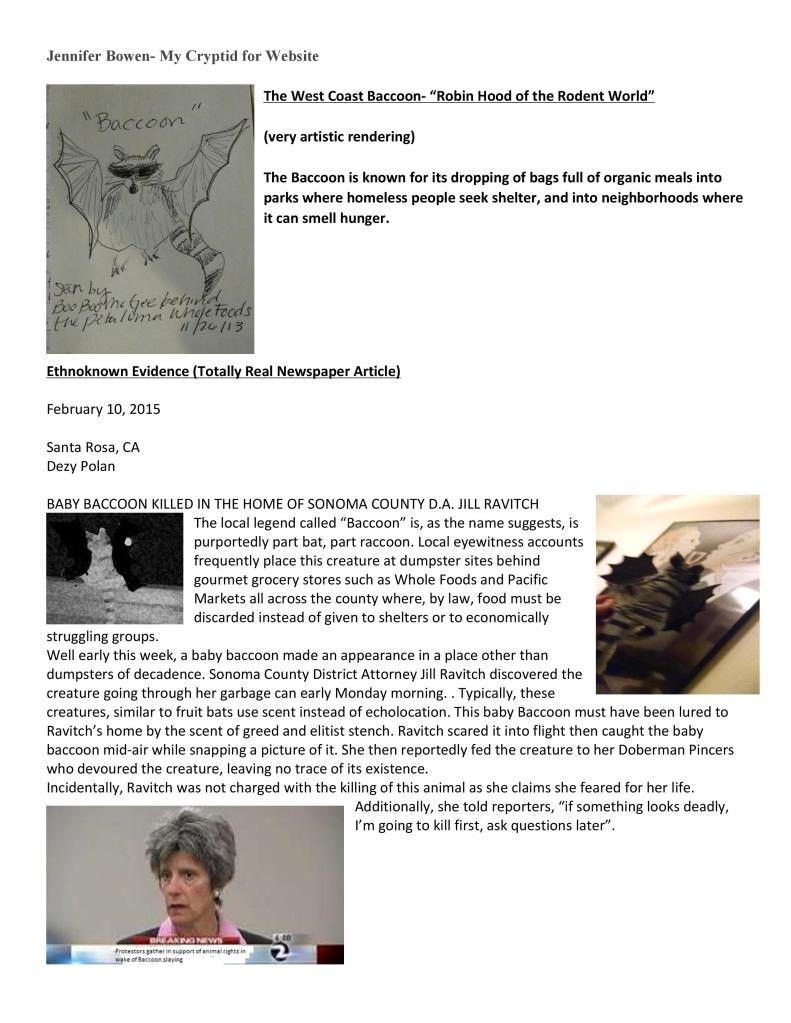
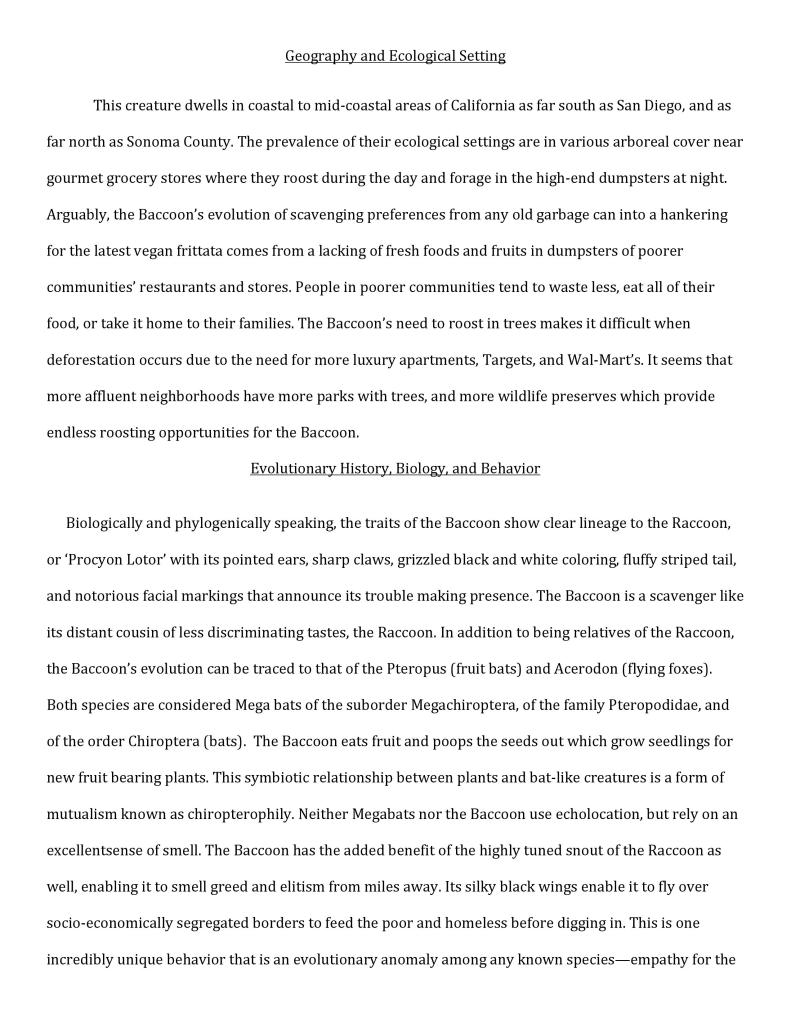



——————————————————————————————————————————————

